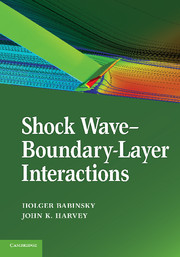Book contents
- Frontmatter
- Brief Contents
- Contents
- Contributors
- 1 Introduction
- 2 Physical Introduction
- 3 Transonic Shock Wave???Boundary-Layer Interactions
- 4 Ideal-Gas Shock Wave???Turbulent Boundary-Layer Interactions (STBLIs) in Supersonic Flows and Their Modeling: Two-Dimensional Interactions
- 5 Ideal-Gas Shock Wave???Turbulent Boundary-Layer Interactions in Supersonic Flows and Their Modeling: Three-Dimensional Interactions
- 6 Experimental Studies of Shock Wave???Boundary-Layer Interactions in Hypersonic Flows
- 7 Numerical Simulation of Hypersonic Shock Wave???Boundary-Layer Interactions
- 8 Shock Wave???Boundary-Layer Interactions Occurring in Hypersonic Flows in the Upper Atmosphere
- 9 Shock-Wave Unsteadiness in Turbulent Shock Boundary-Layer Interactions
- 10 Analytical Treatment of Shock Wave???Boundary-Layer Interactions
- Index
- References
2 - Physical Introduction
Published online by Cambridge University Press: 05 June 2012
- Frontmatter
- Brief Contents
- Contents
- Contributors
- 1 Introduction
- 2 Physical Introduction
- 3 Transonic Shock Wave???Boundary-Layer Interactions
- 4 Ideal-Gas Shock Wave???Turbulent Boundary-Layer Interactions (STBLIs) in Supersonic Flows and Their Modeling: Two-Dimensional Interactions
- 5 Ideal-Gas Shock Wave???Turbulent Boundary-Layer Interactions in Supersonic Flows and Their Modeling: Three-Dimensional Interactions
- 6 Experimental Studies of Shock Wave???Boundary-Layer Interactions in Hypersonic Flows
- 7 Numerical Simulation of Hypersonic Shock Wave???Boundary-Layer Interactions
- 8 Shock Wave???Boundary-Layer Interactions Occurring in Hypersonic Flows in the Upper Atmosphere
- 9 Shock-Wave Unsteadiness in Turbulent Shock Boundary-Layer Interactions
- 10 Analytical Treatment of Shock Wave???Boundary-Layer Interactions
- Index
- References
Summary
Shock Wave–Boundary-Layer Interactions: Why They Are Important
The repercussions of a shock wave–boundary layer interaction (SBLI) occurring within a flow are numerous and frequently can be a critical factor in determining the performance of a vehicle or a propulsion system. SBLIs occur on external or internal surfaces, and their structure is inevitably complex. On the one hand, the boundary layer is subjected to an intense adverse pressure gradient that is imposed by the shock. On the other hand, the shock must propagate through a multilayered viscous and inviscid flow structure. If the flow is not laminar, the production of turbulence is enhanced, which amplifies the viscous dissipation and leads to a substantial rise in the drag of wings or – if it occurs in an engine – a drop in efficiency due to degrading the performance of the blades and increasing the internal flow losses. The adverse pressure gradient distorts the boundary-layer velocity profile, causing it to become less full (i.e., the shape parameter increases). This produces an increase in the displacement effect that influences the neighbouring inviscid flow. The interaction, experienced through a viscous-inviscid coupling, can greatly affect the flow past a transonic airfoil or inside an air-intake. These consequences are exacerbated when the shock is strong enough to separate the boundary layer, which can lead to dramatic changes in the entire flowfield structure with the formation of intense vortices or complex shock patterns that replace a relatively simple, predominantly inviscid, unseparated flow structure. In addition, shock-induced separation may trigger large-scale unsteadiness, leading to buffeting on wings, buzz for air-intakes, or unsteady side loads in nozzles. All of these conditions are likely to limit a vehicle's performance and, if they are strong enough, can cause structural damage.
Information
- Type
- Chapter
- Information
- Shock Wave-Boundary-Layer Interactions , pp. 5 - 86Publisher: Cambridge University PressPrint publication year: 2011
References
Accessibility standard: Unknown
Why this information is here
This section outlines the accessibility features of this content - including support for screen readers, full keyboard navigation and high-contrast display options. This may not be relevant for you.Accessibility Information
- 15
- Cited by
